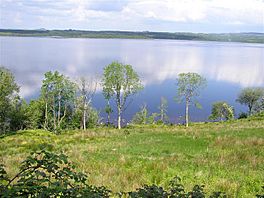Lough Melvin facts for kids
Quick facts for kids Lough Melvin |
|
|---|---|
 |
|
| Location | County Leitrim and County Fermanagh |
| Coordinates | 54°26′N 8°10′W / 54.433°N 8.167°W |
| Native name | Loch Meilbhe Error {{native name checker}}: parameter value is malformed (help) |
| Primary outflows | River Drowes |
| Catchment area | 265 km2 (102 sq mi) |
| Basin countries | Ireland and the United Kingdom |
| Max. length | 12 km (7.5 mi) |
| Max. width | 3 km (1.9 mi) |
| Surface area | 21.25 km2 (8.20 sq mi) |
| Max. depth | 45 m (148 ft) |
| Islands | Inishtemple, Inishkeen, Inishmean, Inisheher, Gorminish, Bilberry Island |
| Settlements | Garrison, Rossinver, Buckode, Kinlough |
Lough Melvin (pronounced lokh MEL-vin) is a beautiful lake in the northwest of Ireland. It sits right on the border between County Leitrim in the Republic of Ireland and County Fermanagh in the United Kingdom. This lake is famous around the world because it has many special plants and animals that you won't find anywhere else.
Contents
Ecology: Keeping Lough Melvin Healthy
The water in Lough Melvin is very clean and healthy. Around 2001-2003, experts said it had an "oligotrophic" rating. This means the water has low levels of nutrients. This is good because it helps keep the lake clear and supports its unique wildlife.
However, Lough Melvin, like other lakes in Ireland, faces threats. Some plants and animals that are not native to the lake can cause problems. These are called invasive species. They can take over and harm the native plants and animals. Some of these invaders include curly waterweed, zebra mussels, and freshwater clams. It's important to stop these species from spreading to protect the lake's special environment.
Amazing Fish of Lough Melvin

Lough Melvin is a very popular spot for fishing. People come here to catch different types of fish. You can find Atlantic salmon here from February to May. Smaller salmon, called grilse, are caught from May to July. The lake is also home to three special types of trout: the gillaroo, sonaghan, and ferox trout.
Lough Melvin is also the only place in the world where you can find a unique type of fish called the Melvin charr, also known as Gray's charr (Salvelinus grayi). This fish is now critically endangered, meaning it is at high risk of disappearing forever.
If you are new to fishing in Lough Melvin, it's a good idea to hire a ghillie. A ghillie is a local guide or boatman who knows the lake very well. They can help you find the best fishing spots.
Gillaroo Trout: The Red Fellow
The gillaroo (Salmo stomachius) is a special type of trout found only in Lough Melvin. Its name comes from the Irish words Giolla Rua, which means "Red Fellow." This name fits because of its bright colors. Gillaroo trout have a golden-yellow body with bright red and orange spots.
These fish mostly eat snails and other small creatures living at the bottom of the lake. However, in late summer, they sometimes come to the surface to feed. This is when anglers can catch them using a special type of fishing called dry fly fishing.
Sonaghan Trout: The Deep Water Hunter
The sonaghan trout (Salmo nigripinnis) is another unique fish found only in Lough Melvin. It can be light brown or silvery with large, clear black spots. Its fins are dark, often black, and its pectoral fins (the ones on its sides) are long.
Sonaghan trout live in the deeper, open parts of the lake. They eat tiny creatures that float in the middle of the water, like water fleas and midge larvae. The best way to catch sonaghan is by fly-fishing from a boat. They put up a strong fight, even though they are not huge fish!
Ferox Trout: The Ancient Hunter
The ferox trout is a very old type of trout that has lived in Ireland for perhaps 50,000 years. Scientists have found that ferox trout are a separate group of trout. They return to specific areas in the lake to lay their eggs.
Ferox trout are known to eat other fish, including smaller brown trout. They also prey on other fish species in the lake. The best way to catch a ferox trout is by trolling. This means pulling a fishing lure, like a Rapala lure, behind a moving boat.
Panoramic View



